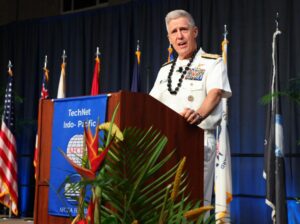TechNet Indo-Pacific 2025 met Oct. 28-30 under unusual circumstances: a monthlong government shutdown. But hosts AFCEA International and the AFCEA Hawaii Chapter shared that they “remain[ed] committed to delivering this mission-essential conference” and welcomed government workers and military members at no cost.
The event, held at the Hawaii Convention Center in Honolulu, typically attracts attendees who work in service cyber components, agencies, GovCon, academia, and the military. This year’s theme was “Sword & Shield: Ensuring a Secure, Free, and Prosperous Indo-Pacific.” Nearly 400 exhibitors showed off their newest technologies aimed at helping the military meet its mission.
AI Drive

Communications, IT, and cyber panel discussion at TechNet Indo-Pacific 2025. Photo credit: AFCEA SIGNAL
The technology on everyone’s minds this year was AI. In fact, AI will likely touch every warfighting function in the Indo-Pacific region, an area that stretches from Africa’s east coast to the U.S. West Coast, said Col. Jared Voneida, U.S. Marine Corps, C4 Operations Division chief, U.S. Indo-Pacific Command J63.
“Easily the most disruptive technology that we have coming our way is artificial intelligence,” Voneida added. “It is simply impossible for a theater this size and commanders with the areas that they have to cover to be able to do it the old way [with] PowerPoint slides [and] getting outbriefs. That information is too stale. We need to leverage technology in order to speed up our decision cycle.”
Specific areas of focus include speeding decision-making, predictive analytics for logistics, target identification, and weapon-to-target pairing, and he emphasized the need for commanders to know what tools would benefit them the most.
“It gives us a lot of flexibility to pivot to certain industry partners when we want to leverage one capability over the next,” Voneida said. “Having that foundation in place, all the data that feeds into the AI, that’s the homework that we need to do right now.”
Applications for AI
For Brig. Gen. Ray Phariss, commanding general, 311th Signal Command, AI’s potential ranges from writing better papers to making complex decisions. “I think there’s almost unlimited applications for it, but you need to know what you’re doing before you start,” Pharris said. “I would say the problem sets that are the most attractive for this are going to be those where it’s a very complex decision [and] we need to bring in a lot of different data and make quick decisions.”
AI is also being used in three main ways to bolster the electromagnetic spectrum (EMS), fast becoming an essential warfighting tool, said Bob Marcial, chief spectrum manager at U.S. Pacific Command:
- Models can predict patterns in the EMS that let service members anticipate interference, enabling them to optimize frequency allocation.
- AI-based tools can resolve frequency conflicts without human help.
- AI allows for spectrum automation so that officials can conduct real-time spectrum management.
Col. Brett Cochran, commander, 613th Air Operations Center, said the center is working with GovCon to develop a data layer. “We’re testing that, or exercising with that, making sure that we can get cloud capability and those kinds of things, and it’s been working great,” Cochran commented.
Network Revamp

Adm. Stephen Koehler, commander, U.S. Pacific Fleet. Photo credit: AFCEA SIGNAL
Part of harnessing AI is an opportunity to rearchitect networks. Currently, there is a “patchwork quilt of networks,” Voneida stated. For instance, within a 5-mile radius of Pearl Harbor, there are eight Department of Defense networks.
He wants to ensure that data is standardized, tagged, and accessible to make access to it easier — and to be a foundation for AI use.
Navy sailors are also looking to overhaul the way they use data. The first step, said Adm. Stephen Koehler, commander, U.S. Pacific Fleet, is developing a symbiotic relationship between AI and data. “We are using AI on nearly every network to develop familiarity with our team and improve decision-making throughout our commanders,” Koehler added. “We’re embracing a hybrid government/commercial approach that partners with private-sector leaders to accelerate innovation on AI, and we are working with partners in industry and government to integrate it into our day-to-day functions and operations.”
What’s more, sailors are using commercially available data fabric and data centers in the Indo-Pacific region to achieve persistent connectivity for distributed maritime operations, he said.
“I want to take our partnership with industry to even greater heights,” Koehler stated. “Let’s continue to strengthen our rapid acquisition strategy, put our best technology in the hands of our service members as soon as possible, and continue to outpace the competition.”
Staying Focused
Ultimately, GovCon and government officials must not underestimate the complexity of the Indo-Pacific theater, leaders said. The region is home to the world’s five largest militaries and encompasses 60% of the world’s population, spanning 16 time zones and 36 countries of varying topography.
“The operational realities of maintaining readiness, projecting power, fighting forward on and from the land, while sustaining the joint force across vast distances, is the reality of this theater,” said Gen. Ronald Clark, USA, commanding general, U.S. Army Pacific. “In a world where technology advances at a breathtaking pace, it is imperative that we not only encourage but embrace innovation.”
We look forward to a more normal environment for TechNet Indo-Pacific 2026 and an update on the goals set this year!
